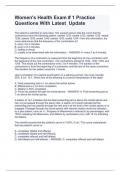Exam (elaborations)
Women's Health Exam # 1 Practice Questions With Latest Update
- Course
- Institution
The frequency of a contraction is measured from the beginning of one contraction until the beginning of the next contraction. The contractions started at 1232, 1235, 1239, and 1243. This would put the contractions every 3 to 4 minutes. The duration of the contractions is from the beginning of a con...
[Show more]



